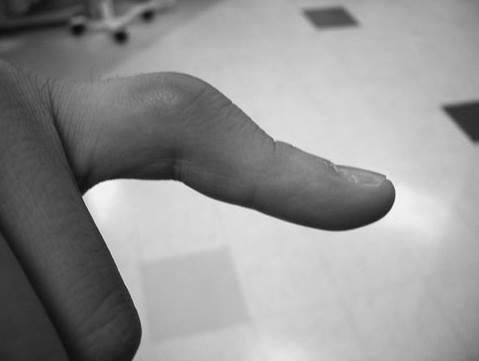A 33-year-old chef presents to the ED with a complaint
of a deformity in his finger. He states that a few weeks ago he sustained a deep laceration over the dorsum of his finger but never sought medical attention for it. On examination, the wound is
well-healed, but there is an obvious deformity as shown in the pic below. Which of the following is the most likely diagnosis?
A. Swan-neck deformity
B. Boutonniere deformity
C. Bell-clapper deformity
D. Mallet finger deformity
answer: B. Boutonniere deformity may manifest acutely following trauma, but most are found weeks
following the injury or as the result of progressive arthritis.
The proximal interphalangeal (PIP) joint of the finger is flexed, and the distal interphalangeal (DIP) joint is hyperextended.
The deformity is due to a disruption of the central slip, which is the main component of the
extensor mechanism at the PIP joint. Weakening or disruption of the central slip, with compromise of
the triangular ligament results in volar migration of the lateral bands of the PIP joint. As the deformity
progresses, the newly dominant flexor superficialis creates constant flexion at the PIP joint. As
the intrinsic muscles (lumbrical and interosseous) lose their insertion into the middle phalanx due to
the incompetent central slip, their force is diverted entirely through the lateral bands. Over time, these
lateral bands migrate palmarly and contract. This is accompanied by secondary shortening of the
oblique retinacular ligaments. Subsequently, these changes cause hyperextension at the DIP joint.
(A) A swan-neck deformity, typically defined as PIP joint hyperextension with concurrent DIP joint
flexion that occurs in ~50% of patients with rheumatoid arthritis.
(D) A Mallet finger occurs when the extensor tendon of a finger is either forcibly stretched or avulsed from the distal phalanx and tdistal portion of the finger hangs in flexion.
(C) A bell-clapper deformity occurs when there is failure of normal posterior anchoring of the gubernaculum, epididymis, and testis. The bell-clapper deformity allows the testicle to twist spontaneously on the spermatic cord that causes venous occlusion and engorgement, with subsequent arterial ischemia causing infarction of the testicle. It is not relevant to orthopedic injuries.

No comments:
Post a Comment